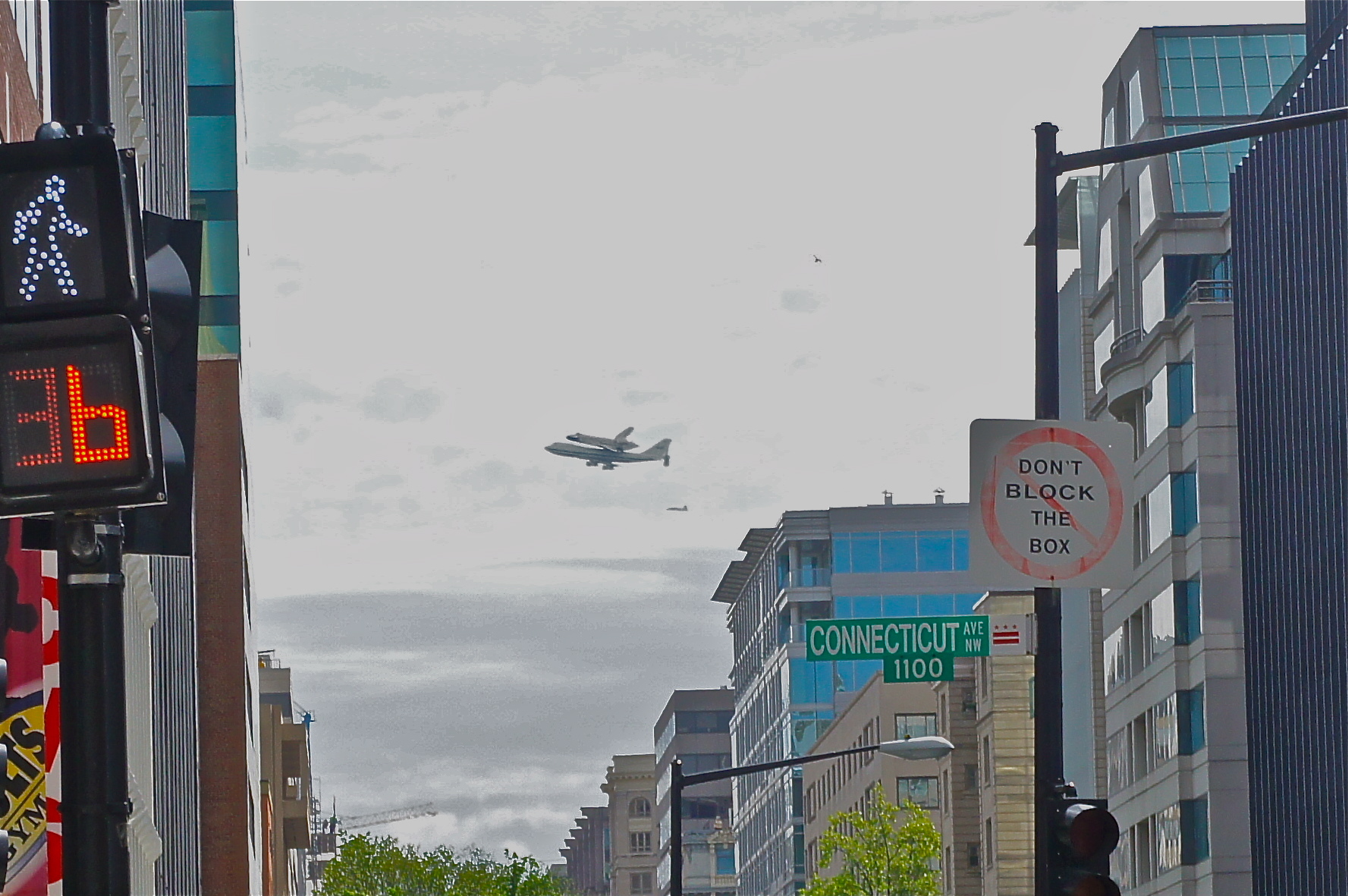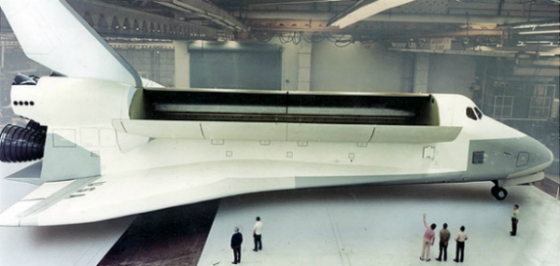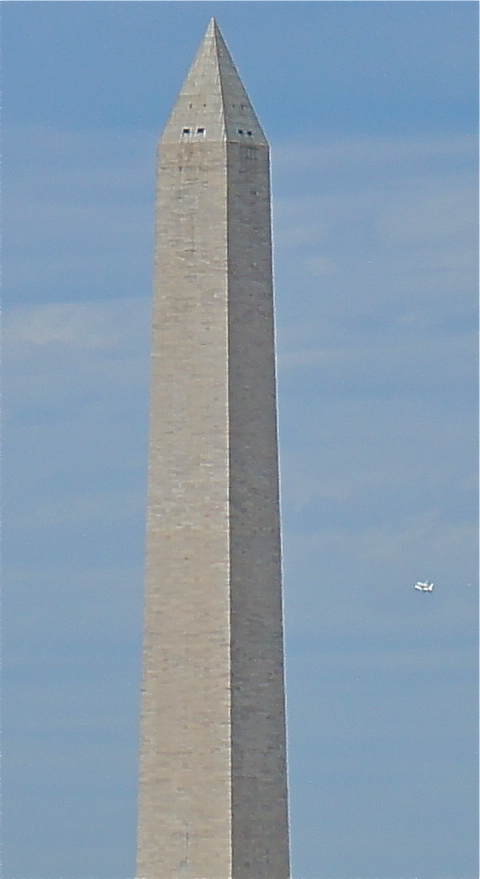AARP Eye Center
Discovery: A Grande Dame's Final Curtain Call
By Bill Newcott, April 17, 2012 04:01 PM

It was visible for just five seconds or so, gliding between the buildings on L Street here in Washington, D.C., but I still managed to raise my camera and snap one last shot of the Space Shuttle Discovery as it headed toward its final home at Dulles International Airport this morning.
It wasn't even 10 a.m., the time the news had said Discovery would begin making the rounds atop its specially outfitted Boeing 747. I was glad for that glimpse, but I also felt cheated out of a longer look-and it occurred to me that's precisely the way I feel about the whole Shuttle program.

The Shuttle and I, you see, go way back. My first newspaper job in 1977 was at a small daily paper in Downey, California, home of the Rockwell plant where many of the shuttle's parts were assembled. One day the city editor assigned me to buttonhole then-(and now!) Governor Jerry Brown during a visit the Downey Rockwell plant and ask him about progress on the then-stalled Century Freeway, a huge local story at the time.
I walked through a set of doors and into the large room where Jerry was scheduled to speak-and there, its tail nearly touching the high ceiling of the place, was the first full-scale mockup of the Shuttle. At the time, almost no one had ever set eyes on the thing, and it was breathtaking. I can still feel the electricity that shot through my body as I stood there, no doubt with my mouth hanging open. I was only vaguely aware of the wiry frame of the governor, standing right there next to me.
"You got something to ask me?" he said.
I swiveled my head slowly in his direction. Some guy in a suit mumbled in his ear.
"He's asking me about the Century Freeway?" Brown scowled. "I haven't made a decision on that yet." And then he was gone. My first big-time interview, and somehow I came away with the quote I needed without having actually asked a question. Or uttered a sound, for that matter.
(UPDATE: Downey has recently put the old plywood Shuttle mock-up back on display: Here's a piece about plans for a permanent home)
Hired to write for The National Enquirer (at four times what I was making at my little newspaper), I moved my family to South Florida in 1980, just in time to witness the first smoky plumes of those early Shuttle launches from our back yard. Night launches were particularly spectacular, even from Palm Beach, more than 100 miles to the south of Cape Canaveral.
I vividly remember driving my kids to school the morning of January 28, 1986, the coldest day anyone could remember in South Florida. A neighbor's sprinkler system had gone on the night before, and foot-long daggers of ice hung from his palm trees. Around lunch time, I was walking down the sidewalk outside my office when I noticed the Shuttle's familiar smoke plume, right at its usual spot on the horizon. Then the smoke blossomed into a ball, and then two smaller, crazily twisting plumes grew from the sphere.
"That's not right," I said aloud, and I was right. By the time I got to my car and turned on the radio, the man who'd been reporting on the Challenger launch was already crying.
In 1990 I came to Washington, where I became space editor for National Geographic magazine. The shuttle, of course, was a big part of my beat, and never more so than when I covered John Glenn's return to space aboard Discovery in 1998. I spent days with Glenn and his fellow astronauts as they trained in Houston, and while they were all on a break one day a very nice guy let me sit in the Commander's cockpit seat aboard the full-size shuttle mockup that NASA kept in High Bay 9N.
For Discovery's launch with Glenn aboard, my son Nick and I got to perch on a sea wall in front of the Kennedy Space Center press stand. We were three miles from the launch pad, but aside from the astronauts themselves, there was no human being any closer than we were to the shuttle. When Discovery's giant engines roared to life, and the craft began its impossibly slow ascent, I was less aware of hearing the pounding onslaught than of feeling it, deep in my chest.

So when I walked into the street and saw Discovery flying by before I was ready for her this morning, my heart sank a bit. I hurried back to the AARP offices and took an elevator to the roof just in time to catch a glimpse of her heading past the Washington Monument and on to Dulles, where I'll get to see her again up close one of these days.
She's the most beautiful machine ever made, but I guess I have to admit the time had come to shut her down. Despite the billions of dollars and millions of man hours spent in its service, the Shuttle was, quite simply, not very safe. Think about it: The shuttles flew about 135 times, and twice everyone on board was killed. You wouldn't accept those odds the next time you boarded an airliner, would you?
Then again, although NASA liked to make us feel like vicarious Shuttle astronauts, we always knew the men and women who actually flew the thing were a breed apart.
John Glenn cut his aviator's teeth on danger-in Korea he earned the nickname "Magnet Ass" because he drew so much antiaircraft fire. He carried that acceptance of the inevitability of danger aloft with him into space.
"Nothing is one hundred percent risk free-nothing," he told me. "But the gain to be made is worth that risk. That just goes with the occupation."
Now Discovery sits in a museum, left fittingly scorched and scarred from her years in orbit. Glenn told me of gazing out the space ship's window at the beautiful Earth below, and how tears filled his eyes-but didn't fall, because there was no gravity.
Today, more than a few tears fell. Some of regret, but mostly of gratitude.
PHOTO CREDITS Top and Bottom: Bill Newcott; Shuttle Mock-up image: NASA























































